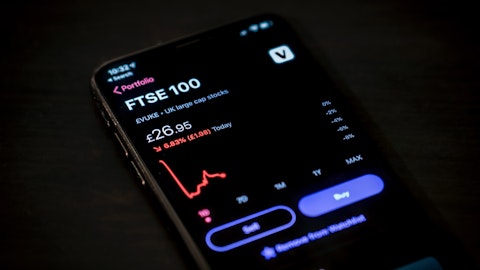Jon Kessler: Yes. The primary factor that has been driving the deceleration in asset growth during the €“ on a sequential basis has really been €“ it’s something we commented on in the text, and that’s a decline in asset values over the period. So I think we actually tried to quantify that a little bit in the text. And what, I guess, I would say is remarkable and helpful is that during that period, that we haven’t seen fundamental changes in consumer contribution behavior or the like. I do think there’s been a little bit of a pullback that’s just based on exactly what you would expect when you have high inflation, you tend to have those savings rates, that kind of thing. But that is very modest. And the biggest effect that we’ve seen there is market net asset value. So those have a way of, as you well know, kind of reverting to a mean. So we’re just going to keep trying to do our thing. And I think over time, that will work itself out just fine.
Gregory Peters: Okay. And then, I guess, my follow-up question from a macro perspective. Last time rates started to move up which was some time ago. We started to see some changes in competitive behavior around their attitudes of service revenue versus custodial revenue versus interchange. And I thought I was just wondering if there’s been any noticeable change in the competitive landscape favoring custodial versus service considering the movement in rates, et cetera?
Jon Kessler: I’d like to believe, Greg, that people have gotten a lot smarter about this, recognizing that rates go up and rates go down. What I do think is the case that is that if you look at this, let’s say, three €“ well certainly at the start of the pandemic, right, as you’ll recall, I remember you asking a question about negative rates. Obviously, it’s not just that we’re far from that. It’s that I think it’s fair to say that the consensus of what a normalized rate environment looks like actually is probably not €“ it’s clearly, it ain’t zero, it ain’t one, it ain’t two. And so I think people kind of understand that a little better. And so we’re not seeing quite of the same sort of, I’m going to call it, where some people were like, “Oh, this is going to last forever.
Let’s do X, Y or Z on five-year agreements. But it’s a piece of the puzzle in terms of aggregate service fees. I also point out, too, that, as you know, but others might not, our service fee revenue today comes primarily from our CDB products. Our HSA service revenue on a year-over-year basis is growing at more or less, as I think I said in the commentary, it’s more or less the rate of account growth. CDB is where we’ve been more challenged as we discussed last quarter and the quarter before, which is not fundamentally about competition, it’s fundamentally about some of our challenges as we finished up the CDB side of the WageWorks migration. But look, I’ve always said there’s some level of for lack of a better term elasticity between service fees and rates.
But I do think people are a little bit, let’s say, I think, a little bit smarter about the fact that they have to look at normalized rates over an extended period of time as opposed to what yesterday’s Fed funds rate was.
Gregory Peters: Okay. Got it. Thanks for the answers.
Jon Kessler: Thank you.
Operator: Our next question comes from Glen Santangelo with Jefferies. Please go ahead.
Jon Kessler: Hi, Glen.
Glen Santangelo: Hey, how are you guys doing? Thanks for taking my question. Hey, Jeff, Tyson, I just wanted to unpack this 2024 guidance in a little bit more detail. If you look at sort of the third quarter results, you put up a 34% gross margin and your initial fiscal 2024 guidance is calling for an EBITDA margin of 33% to 34%. So it looks like it takes a little bit of a step back, which is a little bit surprising just given the growth in the custodial revenues and given the gross margins around that custodial business. So Tyson, I was wondering if you could unpack the margins a little bit and give us a sense for what you’re assuming in 2024 because I don’t know if it’s pricing, I don’t know if it’s a mix of business lines that maybe driving that margin one way or another? Thanks.
Tyson Murdock: Yes. I mean the first thing to really keep in mind, I mean one thing just still look at last year Q4 and just the seasonality of our business. And so when you look at €“ if you back into the margin for Q4 of last year, essentially 25% of EBITDA. Now we’re trending a little better because we’ve got the custodial revenue element in there, but this is really about the service costs coming into play. And I mentioned in the script that they’d be pretty much equivalent in the Q4 time period to what they were last year. As far as that increase that happens between Q3 and Q4. So blending the quarters together, Q3 is always going to be a strong EBITDA margin quarter versus Q4 and say, particularly even Q1 of this year, we talked about some of the service costs that we had flown to that plan.
And so that’s why €“ so when you then blend that together for that guidance for next year and you think about a 33% to 34%, it’s essentially picking up all those quarters, if you will, but still having that same seasonality trending across the respective quarters. Hopefully, that helps. Let me just say one of the things just on the implied guide, I just wanted to make €“ you had said gross margin on the EBITDA margin side, it is like what 33%.
Stephen Neeleman: Yes. It’s in our guide, but now it’s like 31%, 32% for this year for FY2024. So you are looking like a 200 basis point expansion.
Tyson Murdock: Exactly. Yes. I just wanted to make sure that…





